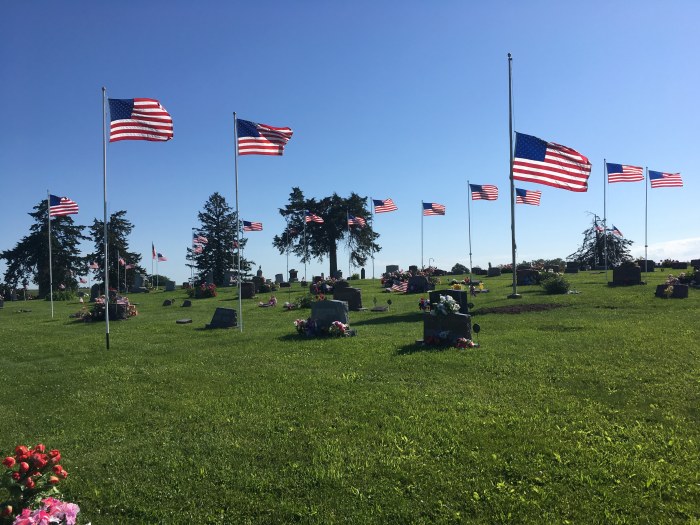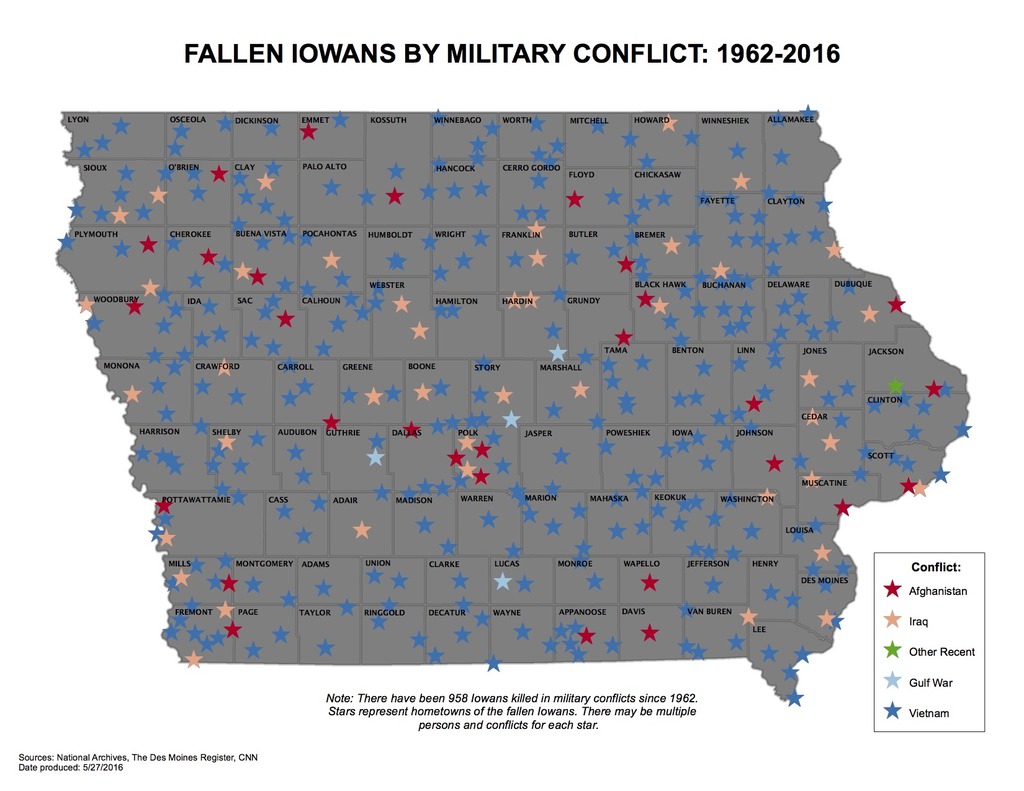President Donald Trump reportedly considered pardoning Americans accused or convicted of war crimes on this Memorial Day. Fox News personalities, not military officials, have pushed for the pardons, which “could erode the legitimacy of military law and undercut good order and discipline in the ranks.”
Former Assistant U.S. Attorney Glenn Kirschner wrote, “These contemplated pardons represent a degradation — not a celebration — of Memorial Day.” Presidential candidate Pete Buttigieg, who served in Afghanistan, commented that Trump’s “idea that being sent to fight makes you automatically into some kind of war criminal is a slander against veterans.”
Since Memorial Day (first known as Decoration Day) is supposed to be about honoring Americans who died during military service, let’s take a moment to consider those soldiers.
The Iowa National Guard’s website includes extensive information about the guard’s history and participation in theaters of war. Two Iowans, Captain Edwin Guthrie of Fort Madison and Major Frederick Mills of Burlington, were killed in Mexico City during the Mexican War of the 1840s. According to the site,
The Mexican War furnished names for several Iowa counties and towns. The Legislature of 1850 created new counties in the northern and western parts of the state. The battlefields and heroes of the late war were fresh in the minds of the people, and their memory was perpetuated in many of the counties named. Buena Vista, Cerro Gordo and Palo Alto were named for famous battlefields. Taylor, Ringgold, Mills, Worth, Butler, Hardin and Guthrie were named for distinguished officers. Numerous towns and townships commemorated other heroes of the war.
Iowans fought in the Civil War in large numbers.
Iowa furnished 48 infantry regiments, 9 cavalry regiments and 4 batteries of artillery. Iowa also furnished one black regiment and a thousand replacement troops.
Iowa’s 76,000 soldiers conducted themselves with honor throughout the war. Twenty-seven received Congressional Medals of Honor. Thirteen thousand died. Many more died from disease than from bullet wounds.
Iowa Public Television reported, “By the end of the war in 1865, 76,534 Iowa men had served in the Union army. In relation to its population, Iowa sent more soldiers to the Civil War than any other state. Of those 13,169 died.”
CORRECTION: According to Leo Landis, curator at the State Historical Museum of Iowa, commented on Twitter that updated research has shown that Ohio sent more soldiers to fight for the Union than Iowa, on a per capita basis.
Disease, especially typhoid fever, also claimed many lives in the Spanish-American War. Iowa National Guard records show one Iowan was killed in action during that “splendid little war,” one went missing from a scouting party, and 163 perished in “non-battle losses.”
The IAgenweb site has many pages devoted to the Great War, more commonly known as World War I.
Over 500,000 Iowans between the ages of 18 and 45 registered for the draft. Iowa sent 114,242 men and women to serve during this war. One of the first U.S. soldiers killed in combat in World War I was an Iowan, Merle Hay, from Glidden. The first U.S. woman to die of injuries in a combat zone also was an Iowan, Marion Crandell, formerly a French teacher at St. Katharine’s School in Davenport. She died while serving in a canteen, when an artillery shell exploded nearby.
Casualty lists from that war can be found here. The Iowa Department of Veterans Affairs calculated that 114,242 Iowans served and 3,576 died during World War I. Iowa National Guard records show,
Seventeen National Guard divisions were assigned to the AEF during World War I. One of the first National Guard divisions to reach France was the 42nd (Rainbow) Division. The 42nd Division was a composite division made up of soldiers from many states. It included Iowa’s 168th Infantry Regiment. Major General William Mann commanded the Division. Major, later General of the Army, Douglas MacArthur was his chief of staff. It was MacArthur who first suggested “Rainbow” as the Division’s name. The 168th Infantry was commanded, in turn, by Colonel Ernest Bennett and Colonel Matthew Tinley.
The 168th Infantry was a consolidated force made up of three prewar regiments of the Iowa National Guard infantry. It was the only Iowa National Guard unit to participate, intact, in the hostilities in France. Many other Iowa Guardsmen, most notably those serving in the 34th Division, were sent overseas. They were sent as replacements, however, and saw active service with the organizations to which they were assigned. […]
At the conclusion of hostilities, the 42nd Division was credited with 164 days of actual combat. The only American divisions to exceed this were the 1st, with 220 days, and the 26th, with 193 days. The Division suffered a 30.6% casualty rate with 2,810 killed and 11, 873 wounded. Of this total, the 168th Infantry suffered over 700 killed and 3,100 wounded.
More Iowans served in World War II (262,638) than in any other military conflict, and the number of fatalities (8,398) was the second-highest after the Civil War. The National Guard site details major combat actions of Iowa units.
The Korean War claimed 508 lives among the 85,341 Iowans who served. This National Archives document lists all the fatalities in alphabetical order.
The Legislative Services Agency compiled this map of Iowans who died in military conflicts from 1962 to 2016.
Vietnam was the deadliest war by far: 115,000 Iowans served, of whom 867 died. Here’s the National Archives document listing all the fallen Iowans from that conflict.
“Nearly one-fourth (23.9%) of the total personnel of the Iowa National Guard” was mobilized during the Persian Gulf War. 3,050 Iowans served and seven died.
Another 885 Iowans served and two died in Panama or Grenada.
The Department of Veterans Affairs published names and pictures of 64 Iowa service members who have died in the Iraq War, 31 who died in Afghanistan, one who died in the Phillippines, and two civilians. The Des Moines Register published the same fallen Iowans’ names and pictures here.
May their memories be for a blessing.


